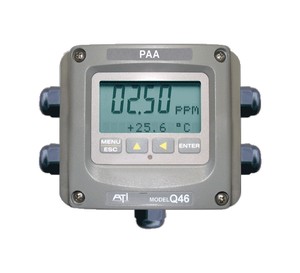- Home
- Products
- Water Measurements
- Analytical Technology Inc.
- Peracetic Acid
- Q46/85 Peracetic Acid Monitor
Q46/85 Peracetic Acid Monitor
- General Details
- Features
- Documents
Peracetic acid (PAA) is an extremely strong oxidizer widely used in the food industry for disinfection of piping systems and processing equipment. It is also used for spray washing of food products, and for disinfection of cooling water systems. As a disinfecting agent, PAA is often preferred because it produces no harmful breakdown products.
As with any disinfection system, maintaining proper residual values is the key to effective pathogen control. To facilitate reliable chemical feed control, ATI has developed an on-line water quality monitor cable of providing real time measurement of low levels of PAA in solution. The Q46/85 Peracetic Acid Monitor uses a direct sensing polarographic probe. The probe is typically used in a flowcell, but a submersible sensor is also available. A permeable diffusion membrane isolates the sensing electrodes from the measured sample, providing long-term stability without electrode fouling problems. The measurement is selective for PAA and is not affected by changes in hydrogen peroxide concentration, which is always present in PAA solutions.
APPLICATIONS
Food & Beverage, Medical Disinfection, Egg Washers, Cooling Water & Wastewater
SENSOR OPERATION
Peracetic acid sensors are amperometric devices isolated from the water by a permeable membrane. As PAA diffuses through this membrane, it comes in contact with an active electrode and is reduced on the surface. The net effect is that the sensor generates a current proportional to PAA concentration. An integral RTD in the sensor provides for automatic temperature compensation, allowing the sensor to operate accurately over a range of 0-50° C.
Peracetic acid sensors are capable of operating over a fairly broad concentration range, from a low range of 0-20 PPM up to a high range of 0-2000 PPM. Systems will operate with good sensitivity down to 0.2 PPM and respond to changes in concentration within about 60 seconds, making them useful for automatic control.
FLOW OPTIONS
Peracetic Acid sensors require a steady flow of sample across the membrane at the tip of the sensing assembly. ATI offers options for flowcells, including the standard constant-head overflow system, and a sealed flowcell for pressures up to 50 PSI. For simplicity of installation, complete flow control assemblies are available. Panel assemblies are available with or without a flow switch and can greatly reduce installation time. For open tank installation, a submersible sensor is available. Sample agitation is required as PAA sensors cannot be used in still water.
Flexibility
Programmable range options from 0-2 PPM up to 0-200 PPM provide maximum application flexibility.
AC or DC Power Options
Power options include universal 90-260 VAC or 12-24 VDC.
Analog Output Options
Two isolated 4-20 mA outputs are standard, with an option for a third output if required. Default setting provides analog outputs for PAA and temperature.
PID Output
Standard PID control function assignable to one analog output.
Digital Communications
Available in either Profibus-DP, Modbus-RTU, Modbus-TCP/IP, or Ethernet-IP.
Relay Outputs
Three SPDT relays are standard, with relay functions programmable for alarm, control, or trouble indication. Three additional low power relays available as an option.
Flexible Mounting
NEMA 4X (IP-66) enclosure is suitable for wall, pipe, or panel mounting.
Clear Display
Back-lit large LCD display provides clear visibility in any lighting conditions. A scrolling second line on the display provides additional information and programming prompts.



